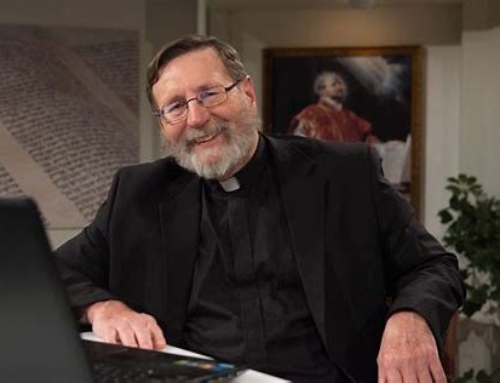Today, on the Feast of St Matthew the Apostle it is worth taking a look at the “Synoptic Problem”. This discussion among Biblical scholars concerns the authorship, development and dating of the first three gospels. They are called the “Synoptic” gospels meaning to look alike or looking the same way. This is because Matthew, Mark and Luke contain many of the same stories and sayings of Jesus–albeit in a different order and categorized differently. Some of the stories are virtually verbatim the same–others have small or significant variations. Studying these similarities and differences in order to work out which gospel came first, and which evangelist used the others as a source is a kind of minor industry among Biblical scholars.
One of the curiosities in his sub-set of scholarship is how the (mostly liberal) scholars rely on their own detective work and scholarship and the conclusions of modern scholarship rather than the teaching of the church fathers of the first centuries. Strange that they should rely on the opinions of mostly Protestant scholars who worked from a sola Scriptura theological assumption rather than giving weight to the theologians and scholars who were actually two thousand years closer to the actual events, not to mention being part of the same cultural mindset. The fact is, the opinions of the early church writers are virtually unanimous that Matthew, Mark and Luke were written by errm–Matthew, Mark and Luke. Matthew also called Levi–the tax collector called by Our Lord, Mark, the assistant and “son in the faith” of St Peter and Luke–the companion of St Paul.
They also agree that Matthew’s was the first gospel to be written, then Mark and Luke. John’s gospel being a separate composition some decades later. This has been challenged in the modern age so that the generally agreed opinion is that Mark’s gospel was the first to be written and then Matthew and Luke’s gospel were composed, using Mark’s gospel as a source. This theory is called Marcan priority. This webpage provides a good overview of the problem.
Whatever the solutions are offered–all of them have strengths and weaknesses: There is content unique to Luke, and content unique to Matthew. There is content in Mark not included in Matthew and Luke. Therefore other theories are devised to solve the problem. “Q” is a proposed (but lost) source document that contained a collection of Jesus’ sayings. “L” and “M” are a proposed sources for the material unique to Matthew and Luke. So the most recent theory is: Mark was written first. Matthew used Mark, “Q” and “M” as his source. Luke used Mark, “Q” and “L” as his source.
However, in researching my book The Mystery of the Magi: The Quest to Identify the Three Wise Men I came across another theory that I found convincing: the idea that Matthew’s was the first gospel written, but it was written in Hebrew/Aramaic for the Jewish community in Judea. This is the theory of the Hebrew gospel or “proto-Matthew”. We do not have any copies of this early version of Matthew’s gospel, but the theory is based on the record of Papias writing in the beginning of the second century who recorded the understanding then current that Matthew was the first to write and he composed a collection of Jesus’ sayings in the Hebrew language and everyone “interpreted them the best they could”. This led to the theory that Matthew’s Hebrew gospel was subsequently translated into Greek (the language of the version of Matthew in our Bibles). However, linguistic scholars do not detect traces of Hebrew or Aramaic translation in Matthew’s Greek gospel.
The existence of the Hebrew gospel was affirmed by St Jerome who claimed not only to have seen the gospel, but to have made a copy. He wrote:
Matthew, who is also Levi, and who from a publican came to be an apostle, first of all composed a Gospel of Christ in Judaea in the Hebrew language and characters for the benefit of those of the circumcision who had believed. Who translated it after that in Greek is not sufficiently ascertained. Moreover, the Hebrew itself is preserved to this day in the library at Caesarea, which the martyr Pamphilus so diligently collected. I also was allowed by the Nazarenes who use this volume in the Syrian city of Beroea to copy it.
Irenaeus also attested to the Hebrew gospel as did Origen and Eusebius. Various scholars through the ages have argued for this theory, most recently James Edwards and Maurice Casey.
Casey argues in Jesus: Evidence and Argument or Mythicist Myths? (2014) that Matthew did compose a sayings collection in Aramaic (a proto-Matthew) that is the source for both the Greek canonical Matthew and Luke. Casey suggests that this is what Papias meant when he said that “each (person) translated/interpreted them as he was able” and that later Church fathers confused proto-Matthew with the Greek Gospel of Matthew. Casey also argues that the Greek Gospel of Matthew is a composite work (that also made use of Mark) that was, in accordance with common custom at the time, attributed “to the fountainheads of tradition” i.e. Matthew.
To summarize, Matthew collected the sayings and stories of Jesus for the Jewish church in Judea. This is consistent with evidence that disciples of rabbis in the first century not only listened, but took notes and recorded the sayings of their rabbi. Matthew, being a tax collector, would have been literate and used to keeping records. This collection of sayings in Hebrew then became the primary source for both Greek Matthew and Luke–the Greek version of Matthew not being merely a translation of the Hebrew Matthew, but a new composition using the Hebrew Gospel of Matthew. The Greek version may have been written by Matthew himself or a later editor/writer, and since its composition was later the author would also have used Mark as a source.
This theory, it seems to me, neatly solves the problem:
- It gives weight to the earliest traditions about the composition of the gospels
- It provides an answer to the requirement that there were sources used by the evangelists
- It supports the early tradition of Matthean priority
- It also supports Markan “priority” allowing Mark’s gospel to be the first written in Greek.
- It allows the Greek Matthew to have used Mark as a source.
- It allows for “L” as an extra source for material unique to Luke’s gospel. (These extra Lucan sources are likely oral eyewitness sources)
- It explains what “Q” and “M” may have been.
I am the first to admit that I am, by no means, a New Testament scholar, but the question is fascinating and I wonder why the hypothesis of a Hebrew Gospel or a “proto-Matthew” is not adopted by more bona fide scholars.
I’ll have to read further on the matter…
In the meantime, happy Feast of St Matthew!






Leave A Comment
You must be logged in to post a comment.